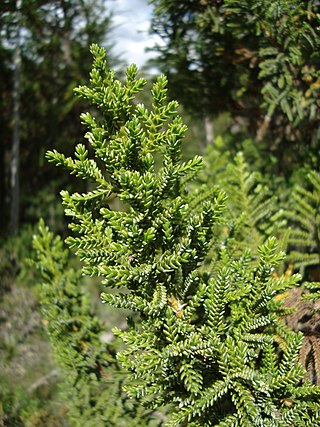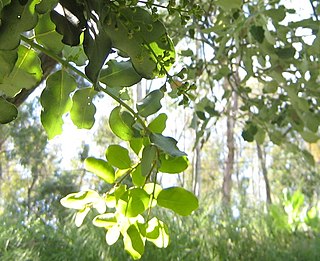
The Valdivian temperate forests (NT0404) is an ecoregion on the west coast of southern South America, in Chile and Argentina. It is part of the Neotropical realm. The forests are named after the city of Valdivia. The Valdivian temperate rainforests are characterized by their dense understories of bamboos, ferns, and for being mostly dominated by evergreen angiosperm trees with some deciduous specimens, though conifer trees are also common.

Pilgerodendron is a genus of conifer belonging to the cypress family Cupressaceae. It has only one species, Pilgerodendron uviferum, which is endemic to the Valdivian temperate rain forests and Magellanic subpolar forests of southern Chile and southwestern Argentina. It grows from 40 to 54°20' S in Tierra del Fuego, where it is the southernmost conifer in the world. It is a member of subfamily Callitroideae, a group of distinct Southern Hemisphere genera associated with the Antarctic flora.

Nothofagus antarctica is a deciduous tree or shrub native to southern Chile and Argentina from about 36°S to Tierra del Fuego, where it grows mainly in the diminishing temperate rainforest.

Cryptocarya is a genus of evergreen trees belonging to the laurel family, Lauraceae. The genus includes more than 350 species, distributed through the Neotropical, Afrotropical, Indomalayan, and Australasian realms.

Nothofagus pumilio, the lenga beech, is a deciduous tree or shrub in the Nothofagaceae family that is native to the southern Andes range, in the temperate forests of Chile and Argentina to Tierra del Fuego, from 35° to 56° South latitude. This tree is in the same genus as the coihue. It regenerates easily after fires. The wood is of good quality, moderate durability, and is easy to work with. It is used in furniture, shingles and construction and sometimes as a substitute for American black cherry in the manufacturing of cabinets.

Nothofagus dombeyi, Dombey's beech, coigue, coihue or coigüe is a tree species native to southern Chile and the Andean parts of Argentine Patagonia. It is a fast-growing species that can live in a wide range of climatic conditions, and forms dense forests. It is cultivated for its timber, and as an ornamental subject.

Gomortega keule is a species of tree endemic to Chile. It is the sole species of the genus Gomortega and, according to the APG IV system of 2016, of the monotypic family Gomortegaceae, assigned to the order Laurales in the clade magnoliids.

Los Ruiles National Reserve is a small nature reserve located in Cauquenes Province of Maule Region in central Chile. The reserve consists of two sections that protect enclaves of native forest, which are home to several threatened and endangered species.

Zona Sur is one of the five natural regions on which CORFO divided continental Chile in 1950. Its northern border is formed by the Bío-Bío River, which separates it from the Central Chile Zone. The Southern Zone borders the Pacific Ocean to the west, and to the east lies the Andean mountains and Argentina. Its southern border is the Chacao Channel, which forms the boundary with the Austral Zone. While the Chiloé Archipelago belongs geographically to the Austral Zone in terms of culture and history, it lies closer to the Southern Zone.

Podocarpus salignus, the willow-leaf podocarp, is a species of coniferous evergreen tree in the family Podocarpaceae. It is found only in Chile, from 35 to 42° south latitude, where it is threatened by habitat loss. Growing up to 20 m (66 ft) in height and 1 m (3 ft) in diameter, the trunk is straight and cylindrical, with reddish-gray bark. The arching branches bear long, narrow, willow-like leaves, and red fleshy oval fruits where male and female plants are grown together. In Chile it is known as Mañío de hojas largas (long-leaved).

Nothofagus alessandrii, the ruil, is a species of plant in the family Nothofagaceae, commonly known as the southern beeches. It is endemic to Chile, occurring chiefly in the Chilean matorral ecoregion. It is threatened by habitat loss. The species is protected within Los Ruiles National Reserve.

Nothofagus alpina, also called rauli or raulí beech is a species of plant in the Nothofagaceae family. A deciduous tree, it grows in Chile and Argentina, it reaches 50 m (160 ft) height and more than 2 meters (6.5 feet) in diameter. Its distribution goes from 35 to 42° South latitude. It is found on the Andes. It tolerates low temperatures and heavy winds. It has a straight and cylindrical trunk with grey bark. N. alpina was proposed to be renamed Lophozonia alpina in 2013.

Nothofagus glauca, commonly known as hualo or roble Maulino, is a species of plant in the family Nothofagaceae. It is a deciduous tree endemic to Chile. It grows from 34° to 37° South latitude. It is a typical tree of the maritime mediterranean-climate Maulino forest of Central Chile, its current range spanning over 330 km from north to south. The species grows on a variety of soils and is mostly found on gentle to steep slopes.

Cryptocarya alba, the peumo or Chilean acorn, is an evergreen tree that grows in Chile and Argentina from 33 to 40° southern latitude. It can live both in wet and as in dry conditions. Its distribution can reach up to 1500 meters (5000 ft) above sea level. It measures up to 20 meters (65 ft) height and one meter diameter, with cracked gray bark. An associate tree is the endangered Chilean Wine Palm, Jubaea chilensis, which species prehistorically had a much wider range.

Beilschmiedia berteroana is a threatened evergreen tree in the family Lauraceae endemic to Chile at 35 to 37°S.

Beilschmiedia miersii, commonly known as the northern acorn tree, is a species of evergreen tree in the family Lauraceae. It is native to central Chile from 30 to 35°S., up to 1200 meters (4000 ft) above sea level and lives under very dry conditions.

Nothofagus nitida is an evergreen tree, native to southern Chile and Argentina. It is found from latitude 40° S to Última Esperanza.

The native flora of Chile is characterized by a higher degree of endemism and relatively fewer species compared to the flora of other countries of South America. A classification of this flora necessitates its division into at least three general zones: the desert provinces of the north, Central Chile, and the humid regions of the south.

The Chilean Matorral (NT1201) is a terrestrial ecoregion of central Chile, located on the west coast of South America. It is in the Mediterranean forests, woodlands, and scrub biome, part of the Neotropical realm.
Myrceugenia colchaguensis is a species of small evergreen tree in the genus Myrceugenia of the family Myrtaceae. It is endemic to Chile where it is found in the coastal mountain range at altitudes below 400 m (1,312 ft). Common names by which this tree is known include colchaguillo, arrayan de colchagua and lumilla.



















